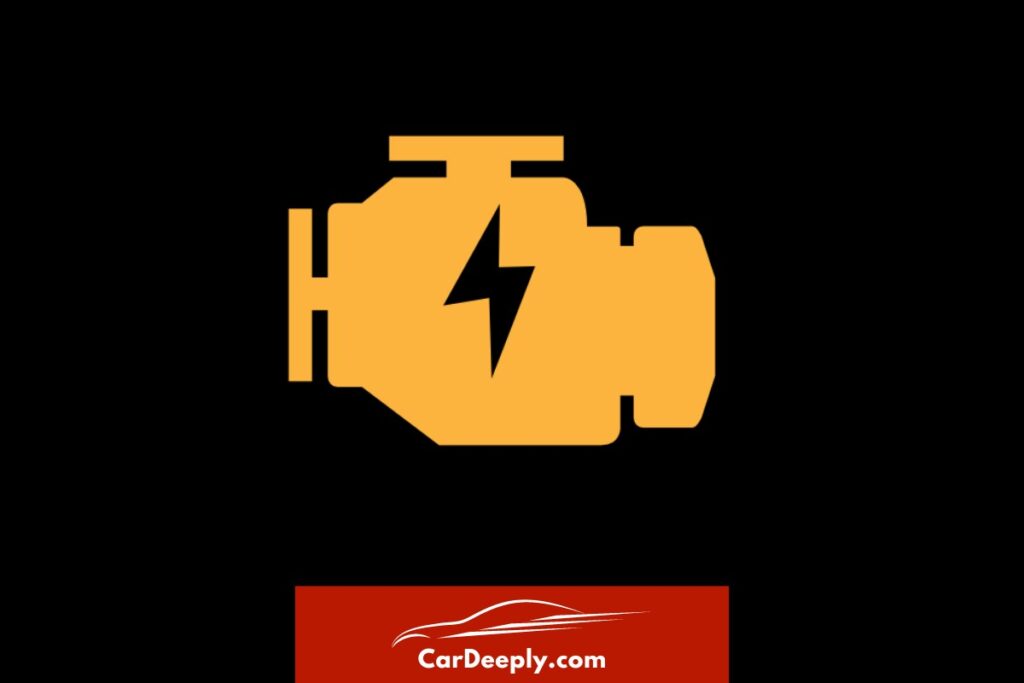Are you tired of that pesky check engine light coming on but unsure what to do?
Don’t worry: we’ve got you covered!
In this guide, we’ll dive deep into the mysterious world of the check engine light, revealing common causes and simple solutions. So get ready to banish that annoying little light once and for all – let’s get started!
Advertising links are marked with *. We receive a small commission on sales, nothing changes for you.
What Does Check Engine Light Look Like?

The check engine light is a small, amber-colored symbol that typically looks like a stylized engine block.
It can be found on your car’s dashboard, among the other warning and indicator lights (see 19 common warning lights in this post).
When this light flash, it signals that your car’s onboard computer has detected a problem in one of its systems. While it may not be as entertaining as other driving aspects, paying attention to the check engine light is crucial, as it helps you address issues before they escalate into more significant problems.
What Does Check Engine Light Mean?
The check engine light is a crucial warning symbol showing that a problem has been found by your car’s onboard computer with one of its systems.
The light is intended to warn you of various potential issues, from minor to more serious, even though it may seem unclear.
Any problems, from a loose gas cap to a broken oxygen sensor or even a failing catalytic converter, can fall under this category.
So even though the check engine light doesn’t offer precise information, it’s your car’s way of signaling that something is off and needs to be checked out.
Time, money, and the headache of future worse problems can all be avoided by taking immediate action.
8 Common Reasons for Check Engine Light Activation
#1: Failure of the Oxygen Sensor
The oxygen sensor tracks exhaust gases to ensure your engine is running with the proper fuel-to-air ratio. Increased emissions and low fuel efficiency can result from a failed sensor.
To avoid further harm and to retain peak performance, replace damaged sensors.
#2: Loose or Damaged Gas Cap
A loose or damaged gas cap, a straightforward but frequent problem, can set off the check engine light. It prevents fuel vapors from escaping, decreasing fuel efficiency and raising pollutants. If necessary, tighten or replace the cap after checking it.
#3: Problems with the Catalytic Converter
The catalytic Converter lowers harmful emissions by transforming pollutants into less damaging gases. However, reduced performance and higher emissions can result from a damaged converter.
A damaged catalytic converter must be replaced to maintain your vehicle’s efficiency and meet emissions regulations.
#4: Issues with Mass Airflow Sensors
By measuring the air entering the engine, the mass airflow sensor aids in determining the proper fuel mixture. A defective sensor might bring on poor fuel efficiency, stalling, or even engine failure.
Issues can be avoided with regular upkeep and cleaning, but if they persist, replacement may be required.
#5: Problems with the Ignition Coil and Spark Plug
When lighting the fuel-air mixture in your engine, spark plugs and ignition coils are essential.
Worn or malfunctioning parts can cause poor fuel efficiency, misfires, and reduced power.
As part of your regular maintenance, check and replace your vehicle’s spark plugs and ignition coils.
#6: Malfunction of the Exhaust Gas Recirculation (EGR) Valve
The EGR valve pumps exhaust gases back into the engine to lower nitrogen oxide emissions.
Poor engine performance, increased emissions, and a broken EGR valve can bring on even engine damage. A replacement valve can be necessary if the valve fails, but routine maintenance and cleaning can help prevent problems.
#7: Leaks in EVAP (Evaporative Emission Control Systems)
To keep gasoline vapors from leaking into the environment, the EVAP system collects and stores them.
This system’s leaks might cause the check engine light to come on, increasing pollutants and decreasing fuel efficiency. Your EVAP system will work effectively if you thoroughly inspect and fix any leaks.
#8: Further Causes
The check engine light can also be caused by several other problems, such as damaged fuel injectors, vacuum leaks, or even a dead battery.
To preserve the health and performance of your car, it is crucial to identify the precise reason for the light and deal with it.
Steps to Take When Check Engine Light Comes On
Step 1: Check for Obvious Issues
- When the check engine light comes on, follow these concrete steps to address any obvious issues:
- Pull over to a safe location and turn off the engine.
- Check the dashboard for other warning lights that may provide additional information about the topic.
- Open the hood and visually inspect the machine for any visible problems, such as loose hoses or damaged belts.
- Ensure the gas cap is tightened correctly. If it’s damaged or worn, consider replacing it.
- Restart the engine to see if the check engine light has turned off. If it persists, proceed to the next steps.
Remember, these steps are only for addressing immediate and visible issues!
Reading tip: Learn how to reset the check engine light without disconnecting the battery in this post.
Step 2: Use an OBD-II Scanner or Visit a Mechanic for a Diagnosis
To pinpoint the issue causing the check engine light, use an OBD-II scanner to read the diagnostic trouble codes stored in your car’s onboard computer.
Alternatively, you can take your vehicle to a professional mechanic who can perform the diagnosis for you.
Step 3: Address the Issue Based on Diagnostic Results
Once you’ve identified the root cause of the check engine light, take the necessary steps to fix the problem. This may involve replacing a faulty part, repairing a leak, or simply adjusting a component.
Consult a mechanic if you need help addressing the issue yourself.
Future Steps: Regular Vehicle Maintenance to Prevent Check Engine Light Issues
Prevent future check engine light occurrences by staying on top of your car’s maintenance.
Follow the manufacturer’s recommended maintenance schedule, including oil changes, filter replacements, and other routine services. In addition, regularly inspect and address worn or damaged parts to keep your vehicle running smoothly and efficiently.
By the way, CarMD issues the Vehicle Health Index every year. This examines the most common reasons and the repairs associated with the engine check engine light going off.
In 2022, those in the top 3 were:
- Replace the Catalytic Converter (s) with new OE Catalytic Converter(s).
- Replace Oxygen Sensor(s) (O2S)
- Replace Ignition Coil(s) and Spark Plug(s)
The Cost of Ignoring the Check Engine Light
Possible Long-Term Damage to Vehicle
Components Ignoring the check engine light can worsen issues, damaging critical components such as the catalytic Converter, engine, or transmission. Addressing problems early can save you from expensive repairs down the road.
Decreased Fuel Efficiency
Many check engines light issues, such as oxygen sensor failure or mass airflow sensor problems, can negatively impact your vehicle’s fuel efficiency. Not addressing these issues means you may spend more on fuel over time.
Increased Emissions and Potential Legal Issues
Ignoring the check engine light can increase emissions, which may cause your vehicle to fail emissions tests. This could result in fines, penalties, or even the inability to renew your vehicle’s registration.
Higher Repair Costs in the Long Run
While ignoring the check engine light might be tempting, doing so can result in more severe problems that require costly repairs. Addressing issues early can prevent complications and save you from potentially expensive repair bills.
Frequently Asked Questions
If my car’s check engine light is on, can I still drive it?
Depending on the problem.
Generally speaking, it is okay to drive to a mechanic if the light is constant and there are no additional warning indicators. But if it blinks or is coupled with other symptoms, immediately pull over and see a mechanic.
How do I reset the check engine light?
After the problem is fixed, the check engine light ought to disappear.
However, if it stays on, you can reset the onboard computer by disconnecting the battery briefly or using an OBD-II scanner to clear the codes.
Is a professional always required to be consulted when the check engine light illuminates?
No, never.
Simple problems, like a loose gas cap, can occasionally cause the light to come on. For a proper diagnosis and repair, visiting a professional technician for more complicated issues is preferable.
How can I prevent the check engine light from coming on in the future?
Check engine light problems can be avoided with routine car care, which includes periodic oil changes, filter replacements, and inspections.
In addition, take immediate action if there are any warning indications to prevent more significant issues.
Conclusion
To sum up, the check engine light is an essential sign of the health of your car, and fixing it right away will help you avoid wasting time, money, and stress.
Using this manual as a reference, you better comprehend the typical causes, respond appropriately when the light shows, and keep your automobile running smoothly.
A safe and satisfying driving experience depends on being proactive with car maintenance and repairs.

Sebastian loves convertibles and drove a BMW 335i for a long time (325 hp is just a dream). Today, with two children, he is more concerned with SUVs and family-friendly vehicles. In addition to an Audi A4 Avant, he also drives a Cupra Formentor VZ – even as a family man, you can’t do without speed. Get to know Sebastian better and visit the About Us page.
Advertising links are marked with *. We receive a small commission on sales, nothing changes for you.
